The processing of advertisements happens quickly, based on emotions, and is 95% unconscious in our brains. By using neuromarketing, which examines the responses of our brains to investigate our behavior and choices, you can optimize advertising messages. Ensure more attention and a longer focus on the key message of your communication. Therefore, we have listed some marketing tricks derived from neuromarketing below.
What is neuromarketing?
The term neuromarketing arises from the concepts of neuroscience and marketing. In neuroscience, the responses of our brains (such as specific emotions) and their influence on our choices, thinking patterns, and behavior are studied. This includes both our conscious and unconscious reactions.
Results and insights from neuroscience research are then applied in the marketing world to create more effective messages. For example, you can conduct a small study to test reactions to a potential new packaging for your product or examine how a price increase for your service would be received by the target audience. If you want to find out what people associate with your brand and how to better respond to it, neuromarketing has the answers.







